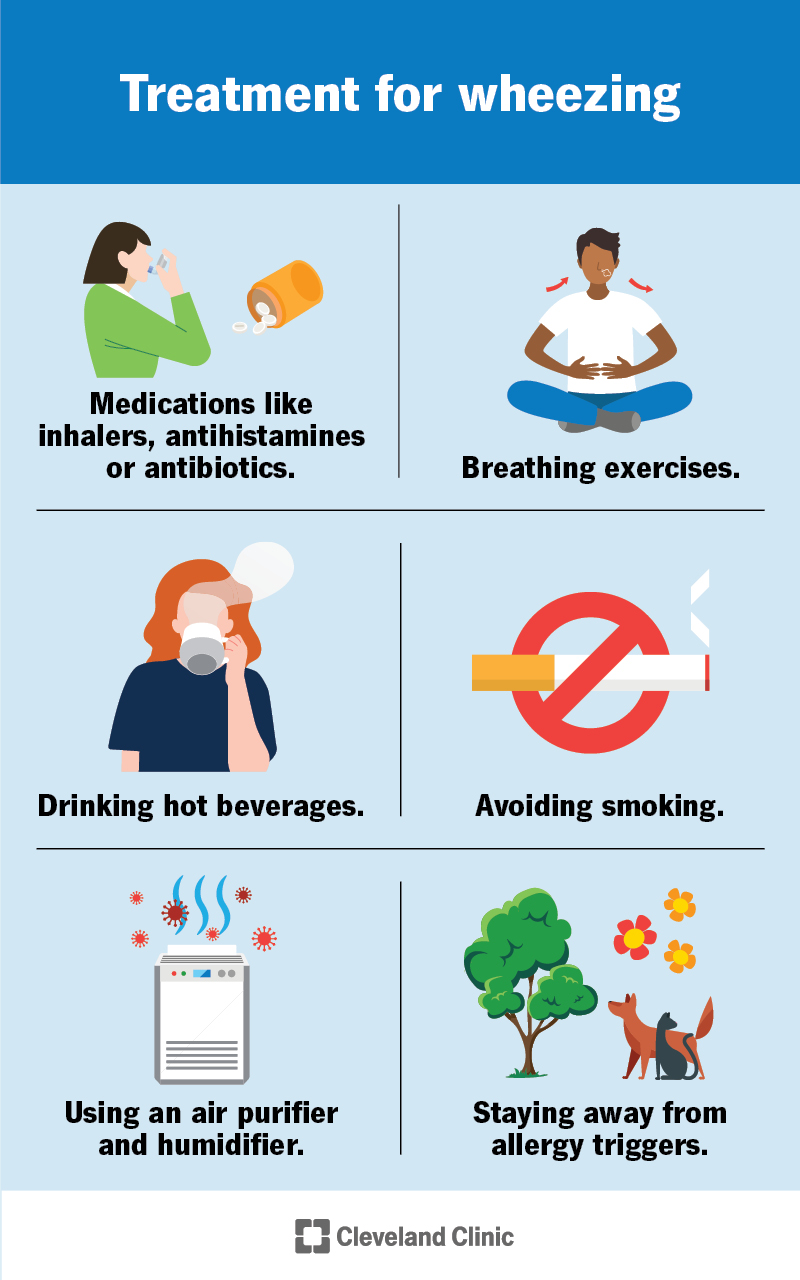Wheezing is the shrill whistle or coarse rattle you hear when your airway is partially blocked. It might be blocked because of an allergic reaction, a cold, bronchitis or allergies. Wheezing is also a symptom of asthma, pneumonia, heart failure and more. It could go away on its own, or it could be a sign of a serious condition.
Advertisement
Cleveland Clinic is a non-profit academic medical center. Advertising on our site helps support our mission. We do not endorse non-Cleveland Clinic products or services. Policy
Wheezing is the shrill, coarse whistling or rattling sound your breath makes when your airway is partially blocked or narrowed. It’s usually most apparent when you breathe out (exhale). Sometimes, it can be a sign that you’re having breathing problems due to an underlying condition. But, other times, wheezing can be a reaction to dust in the air or because you have a cold.
Advertisement
Cleveland Clinic is a non-profit academic medical center. Advertising on our site helps support our mission. We do not endorse non-Cleveland Clinic products or services. Policy
Many treatments are available for wheezing, depending on what’s causing it. Your healthcare provider may recommend seeing a pulmonologist or allergist if your symptoms persist or if wheezing is due to a chronic health condition like asthma.
Some wheezes can only be heard with a stethoscope, but often, you can hear them with your own ears. Wheezing is more obvious when you breathe out but can also be heard when you breathe in. The tone of the wheeze can vary depending on which part of your respiratory system is blocked or narrowed. Narrowing in the upper respiratory system may make for a hoarser wheeze. Lower obstructions may have a more musical tone, like how a wind instrument like a clarinet might sound.
Anyone — from infants to older adults — can develop wheezing. In adults, people who smoke and people with emphysema or heart failure are most prone to wheezing.
Wheezing is also quite common in infants. Up to 25% to 30% of infants develop wheezing in their first year. This may happen because babies have smaller airways. Children under 2 are also more susceptible to wheezing because they tend to get viral upper respiratory infections.
Adults and children with asthma and allergies may also be more likely to experience wheezing.
Advertisement
An obstruction (blockage) or narrowing of the small bronchial tubes in your chest usually causes wheezing. An obstruction in your larger airways or vocal cords can also cause it. The causes range from chronic but manageable conditions like asthma to serious conditions like heart failure.
Many different things can cause wheezing, such as medical conditions, infections or viruses, and lifestyle factors.

Your treatment for wheezing depends on its underlying cause. If you go to the ER or see a healthcare provider, they may begin with oxygen therapy to help you breathe. If wheezing is severe or doesn’t improve with supplemental oxygen, you may need to be hospitalized until your breathing improves.
Most of the time, taking medication to treat the cause of the wheezing improves your symptoms. For example, using an inhaler for asthma or taking antibiotics for an infection usually helps.
Advertisement
If asthma is causing you to wheeze, your healthcare provider will likely prescribe an inhaler to reduce inflammation and open your airways (a bronchodilator). Inhaled corticosteroids and pills such as montelukast (Singulair®) are anti-inflammatory medicines to treat asthma.
If your provider determines bronchitis is causing your wheezing, they may prescribe a bronchodilator such as albuterol (Proair® HFA, Proventil® HFA, Ventolin® HFA) or an antibiotic to heal a bacterial infection. This should help you breathe better as you recover.
Other causes of wheezing may require specific treatments like oxygen therapy. Your provider will prescribe a plan to treat the underlying cause of your condition and soothe symptoms to help you feel better faster.
There are many ways you can improve wheezing at home without a prescription. Some of those treatments include:
Advertisement
See your healthcare provider if your wheezing is new, if it keeps coming back or if any of the following symptoms accompany it:
Your healthcare provider will perform a physical exam, listen to your lungs and breath and ask about your symptoms. Questions could include things like:
Your provider may also order tests like:
Whatever the cause, there are things you can do to get relief. Follow your healthcare provider’s instructions on taking medication, choosing not to smoke (or quitting) and running a vaporizer or humidifier to moisten the air. Doing all these things will help you breathe easier.
If your skin, mouth or nails are turning blue or you’re gasping for air, it’s a sign that your lungs don’t have enough air. This is a medical emergency and you should have a family member or friend take you to the nearest emergency room. If you’re alone, call 911 (or your emergency services number) and describe your breathing.
Advertisement
If you suddenly start wheezing after a bee sting, after you take a new medication or eat a new food, that could indicate an allergic reaction, and you should seek medical attention right away.
Hearing a wheezing sound from yourself or a loved one can be alarming. While it’s not always a reason to panic, an underlying medical condition could be the cause. Wheezing happens when your airways are blocked, and many things can cause it. It may be OK to wheeze when you have a cold or another temporary illness. But if it happens frequently and you become short of breath or blue, seek care from a healthcare provider immediately.
Need care fast? Cleveland Clinic’s Express Care and Urgent Care locations treat everything from sprains to sinus infections — no appointment needed.

Last reviewed on 04/02/2024.
Learn more about the Health Library and our editorial process.